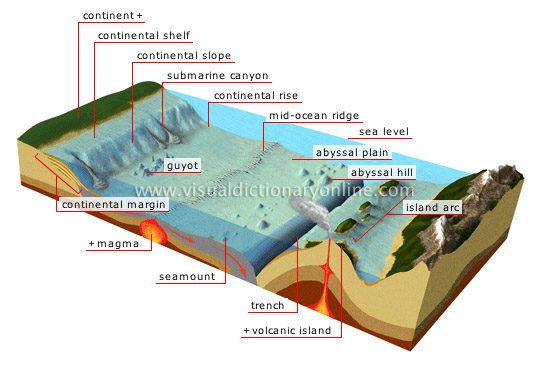ocean floor
Part of the Earth’s surface beneath the seas and the oceans; its topography is highly variable.
continental margin 
Underwater extension of the continent; it comprises the continental shelf, the continental slope and the continental rise.
continental shelf 
Section of the continental margin extending from the coast of the continent to the continental rise; its depth is no more than 660 feet.
guyot 
Ancient volcano whose summit has been cut off by erosion and then submerged.
magma 
Molten rock and gas under very high pressure that can reach extremely high temperatures.
seamount 
Isolated mountain of volcanic origin featuring a pointed summit.
trench 
Extremely deep elongated depression bordering a continent or island arc; it occurs when one tectonic plate moves under another.
volcanic island 
Volcano whose summit rises above sea level.
island arc 
String of volcanic islands formed when two tectonic plates meet.
abyssal hill 
Rounded underwater rise of low elevation.
sea level 
Mean water level observed for a given duration (day, month, year); it is used as a reference to define coastal features and calculate the elevation of topographical elements.
mid-ocean ridge 
Group of underwater mountain chains criss-crossing the oceans; it is formed by an outpouring of magma.
continent 
A collective term for the vast landmasses and their submerged margins.
submarine canyon 
Deep valley that is frequently the extension of a river; it ends in a sediment buildup.
continental slope 
Slope of a few degrees that extends from the continental shelf; it is 660 to 6,600 feet deep.
continental rise 
Gently sloping section of the continental margin; it connects the continental slope to the abyssal plain.
abyssal plain 
Zone located at a depth of 6,600 to 20,000 feet; it covers most of the ocean floor.











